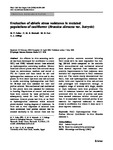Evaluation of abiotic stress resistance in mutated populations of cauliflower (Brassica oleracea var. Botrytis)
| dc.contributor.author | Fuller, MP | |
| dc.contributor.author | Metwali, EMR | |
| dc.contributor.author | Eed, MH | |
| dc.contributor.author | Jellings, AJ | |
| dc.date.accessioned | 2013-02-24T14:54:26Z | |
| dc.date.available | 2013-02-24T14:54:26Z | |
| dc.date.issued | 2006-01-01 | |
| dc.identifier.issn | 0167-6857 | |
| dc.identifier.issn | 1573-5044 | |
| dc.identifier.uri | http://hdl.handle.net/10026.1/1433 | |
| dc.description.abstract |
An efficient in vitro screening method has been developed for cauliflower to create NEU and NMU induced mutant lines selected on hydroxyproline containing medium. Mutant lines and control plants were sub-cultured many times on maintenance medium and stored at 5°C for 2 years and then tested for salt and hydroxyproline resistance as in vitro and in vivo plants. In vitro shoot tips were also sub-cultured to media containing hydroxyproline and NaCl for 28 days and then assessed for their leaf proline content. Non-acclimated and acclimated in vivo plants were also assessed for resistance to freezing. Populations of control and selected lines were created by mass pollination and subsequently tested for their NaCl and frost resistance. Control plants had little or no NaCl or hydroxyproline resistance whilst selected plants showed varying degrees of resistance. In vitro and in vivo responses of selected lines were correlated. Leaf proline content was increased markedly in the mutant lines and the greatest proline contents occurred following NaCl stress with the most respondent line having 100-fold levels compared to the controls. Both non-acclimated and acclimated selected lines showed improved frost resistance over controls. Improvements in frost resistance were heritable but improvements in NaCl resistance were not. The results clearly demonstrated that NaCl, frost and hydroxyproline resistance were stable traits over repeated in vitro sub-cultures and prolonged low temperature storage. A complete range of mutants with single, double or triple resistance traits were produced. The level of resistance however was not necessarily correlated with the level of proline and some lines showed resistance without elevated proline. It is concluded that elevated proline is not essential for improved resistance to abiotic stress in cauliflower, but where it does occur it does improve resistance. © Springer Science+Business Media B.V. 2006. | |
| dc.format.extent | 239-248 | |
| dc.language | en | |
| dc.language.iso | en | |
| dc.publisher | Springer Science and Business Media LLC | |
| dc.subject | NaCl | |
| dc.subject | hydroxyproline | |
| dc.subject | frost | |
| dc.subject | proline | |
| dc.subject | mutant | |
| dc.subject | cauliflower | |
| dc.subject | in vitro | |
| dc.subject | Brassica oleracea L | |
| dc.title | Evaluation of abiotic stress resistance in mutated populations of cauliflower (Brassica oleracea var. Botrytis) | |
| dc.type | journal-article | |
| dc.type | Journal Article | |
| plymouth.author-url | https://www.webofscience.com/api/gateway?GWVersion=2&SrcApp=PARTNER_APP&SrcAuth=LinksAMR&KeyUT=WOS:000239666200011&DestLinkType=FullRecord&DestApp=ALL_WOS&UsrCustomerID=11bb513d99f797142bcfeffcc58ea008 | |
| plymouth.issue | 2 | |
| plymouth.volume | 86 | |
| plymouth.publication-status | Published | |
| plymouth.journal | Plant Cell Tissue and Organ Culture | |
| dc.identifier.doi | 10.1007/s11240-006-9112-4 | |
| plymouth.organisational-group | /Plymouth | |
| plymouth.organisational-group | /Plymouth/Faculty of Science and Engineering | |
| plymouth.organisational-group | /Plymouth/Faculty of Science and Engineering/School of Biological and Marine Sciences | |
| plymouth.organisational-group | /Plymouth/REF 2021 Researchers by UoA | |
| plymouth.organisational-group | /Plymouth/REF 2021 Researchers by UoA/UoA06 Agriculture, Veterinary and Food Science | |
| plymouth.organisational-group | /Plymouth/Users by role | |
| plymouth.organisational-group | /Plymouth/Users by role/Academics | |
| dc.identifier.eissn | 1573-5044 | |
| dc.rights.embargoperiod | Not known | |
| rioxxterms.versionofrecord | 10.1007/s11240-006-9112-4 | |
| rioxxterms.licenseref.uri | http://www.rioxx.net/licenses/all-rights-reserved | |
| rioxxterms.type | Journal Article/Review |


